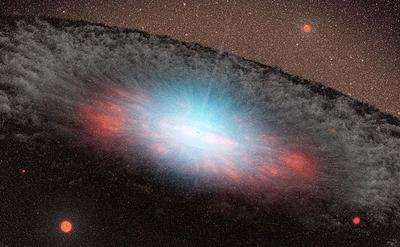Astronomers discover new type of cosmic explosion

An international team of astronomers, including a University of Southampton expert, has discovered a new type of explosion in a distant galaxy.
The explosion, called PS1-10adi, seems to prefer active galaxies that house supermassive black holes consuming the gas and material around them.
Using telescopes on La Palma and Hawaii, the team detected an explosion that was so energetic it must have originated from one of two sources: an extremely massive star – up to several hundred times more massive than our Sun – exploding as a supernova, or from a lower mass star that has been shredded by the ultra-strong gravitational forces close to the supermassive black hole.
The explosion – detailed in a study published in Nature Astronomy – occurred 2.4 billion years ago, but the enormous distance that light from the event had to travel to reach Earth meant it wasn't observed by astronomers until 2010. The slow evolution of the explosion allowed scientists to monitor it for several years.
Dr Cosimo Inserra, of the University of Southampton, was involved in the analysis of data and helped identify the only two possible scenarios that could explain the event. He also tested the data using established physical supernova models to support the results.
He commented: "The discovery we made has revealed explosions capable of releasing an amount of energy ten times bigger than normal explosions.
"Our data show that events like this are not very unusual and challenge our knowledge of exploding and disrupting stars.
"At the same time, their existence provides us with important information about the extreme environment in the central, hidden, part of galaxies."
Lead author Dr Erkki Kankare, of Queen's University Belfast, added: "If these explosions are tidal disruption events – where a star gets sufficiently close to a supermassive black hole's event horizon and is shredded by the strong gravitational forces – then its properties are such that it would be a brand new type of tidal disruption event.
"If they are supernova explosions then their properties are more extreme than we have ever observed before, and are likely connected to the central environments of the host galaxies."
The international team included research institutes from Finland, Sweden, Ireland, Italy, Spain, Chile, and the US.
More information: E. Kankare et al. A population of highly energetic transient events in the centres of active galaxies, Nature Astronomy (2017). DOI: 10.1038/s41550-017-0290-2
Journal information: Nature Astronomy
Provided by University of Southampton




















